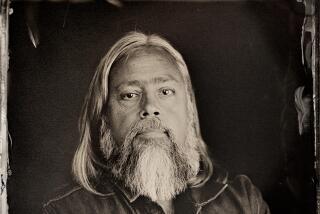A Sioux Anthropologist Remembers Teton Women : WATERLILY<i> by Ella Cara Deloria (University of Nebraska Press: $19.95; 244 pp.) </i>
âWaterlily,â Ella Cara Deloriaâs only novel, is about what it must have been like to live in a Tiyospaye, the Teton Sioux camp circle. Set just prior to white settlement on the Western Plains of North America, the author breaks new ground by writing from the perspective of an insider who focuses on the role of women in Sioux society.
Completed in the early 1940s, this first-published edition is exceptionally timely in that it challenges the still-common notion that Indian women are treated as inferior to the brave warriors, skillful hunters and the holy men of the Great Plains. By presenting the contributions of these women as keepers of the traditions, Deloria allows us to understand the contemporary Lakota women, as they call themselves today.
Unlike Deloriaâs corpus of ethnographic and linguistic work, âWaterlilyâ explores a series of important concepts in an attractive, fictional narrative or conversational style. Thought-provoking yet relaxed, its engaging anecdotes alternate with serious commentary. Combining the experiences, views and insights of a writer who blends previous research with a perspective of the trained insider, the author creates good fiction based on fact. No one is better qualified than Deloria to draw together a series of Sioux female characters such as the ones central to this novel.
âWaterlilyâ stands firmly on its own among books in which Native American women occupy visible, important positions. Unlike the authors of a recent series of trendy novels written by non-Indian women about what they perceive to be the role of Indian women, Deloria, with amiable efficiency and without superficial mystical abstraction, develops the characters of Waterlily, her mother Bluebird and the grandmother Gloku, First Woman, Dream Woman and others in a much more believable light. She soundly challenges the fiction that continues to perpetuate stereotypes.
As the novel opens, the Teton Tiyospaye is once again on the move to a fresh camp site. Continually haunted by the prospect of oncoming change as well as the need for food and shelter, the group moves slowly and cautiously across the land. Bluebird, a young wife, gets out of the moving line of people and looks around in anguish until she spots a line of trees at a short distance. Thinking that thereâs probably water near the trees as well as a place to seclude herself, since her time to give birth has finally arrived, she walks slowly away from the people. As she reaches the trees, everything suddenly changes. Bluebird tries to focus her mind on the newborn child but is continually distracted and cannot keep her eyes off the beauty and the spirit of the waterlilies at the edge of the water where she has gone to wash her newborn child. As she glances from one flower to another, she clearly sees her babyâs face among them. She names her infant Waterlily.
Deloria takes us back in time to when Bluebird was a young, care-free girl. At the age of 14, everything changes. Bluebird loses her mother to an enemy raiding party, and she and her grandmother end up living in another camp circle which, though they are not related as kin, nevertheless takes them in as relatives and social kinships. It is here that Bluebird somehow agrees to marry the unreliable Star Elk.
He takes Bluebird and Gloku to live with his family. Star Elk later abandons Bluebird, their baby Waterlily and Gloku.
Shortly after Star Elk disappears, Bluebird, Waterlily and Gloku are reunited with their own relatives, placing their tepees side by side within easy reach of cooperative living. Bluebird, once again with her own people, senses the feeling of belonging. Through Waterlily, we come to understand how the Teton preserved their cultural values by carefully teaching the children what it means to be Teton women and men and why they must care for, and respect each other.
Eventually Waterlilyâs mother is married for the second time--this time to a man named Rainbow who is everything that Star Elk was not. It is the thoughtful and kind Rainbow who sponsors for Waterlily the elaborate rite hunka , or child beloved, a ceremony for children who were especially selected for a place of honor in Teton society. Through this rite Waterlily is taught the knowledge necessary for understanding the principles of daily life and why ritual practices were important for both men and women.
In some ways the hunka ceremony is similar to female puberty ceremonies held today by the Navajo, Apache and others in that they instruct the young girls of the society about traditional knowledge and why it is necessary for keeping body and spirit together for the survival of the people. After the ceremonies, these girls who have also participated receive a special place within the society.
When the people are not on the move, and are settled for a while, all the women work in the Tiyospaye, caring for the happiness and well-being of the elders and the children. Waterlily matures in this supportive atmosphere.
Through Teton oral traditions, Waterlily learns about the importance of the Winter Count as a way of going back in time and retelling the history of the people. She is taught about ceremonies such as the Buffalo Dreamers and the Vision Quest, a ritual still held today by Lakota men and women.
Watching the men perform the Sun Dance, Waterlily notices a young participant who had earlier attracted her attention. She brings him water, and quickly runs off before he has a chance to see who she is.
Suddenly Gloku dies and although Waterlily has been preparing to marry, she puts her marriage off until she completes the year-long ghost-keeping ceremony to honor her grandmotherâs spirit.
She agrees to marry Sacred Horse, a man who proves to be a good husband and companion, even though she seems to have trouble talking openly with him. Sacred Horse takes her to live with his people. He is eventually killed in a battle and Waterlily, like her mother before her, takes her child and goes back to live with her own family.
Lowanda, Sacred Horseâs cousin, soon arrives to help her raise her child. Waterlily realizes that Lowanda is the same young man that she had given water to at the Sun Dance years ago. The two are suited to each other and eventually marry, with the honor of tribal approval.
Deloria, a Yankton Sioux, was born in 1899 and raised among the Teton Sioux on the Standing Rock Reservation, where her father was the pastor of an Episcopal Church. She grew up in an Indian home, and an environment that also was Christian. In 1929, having earned a Bachelor of Science degree from Columbia Teacherâs College, she began a long collaboration with anthropologist Franz Boas, in which she produced an immense corpus of work on Plains Indian language and culture. âWaterlilyâ is based on her previous work, but written in the form of a novel in an effort to inform a larger number of people about her culture. Those readers who seek to know more about native American women, as well as Sioux culture, change, and, more important, continuity, will be richly rewarded by reading this novel. Those who wish to know more about the author and her previous work, as well as her collaboration with Boas and other anthropologists of her time, will appreciate the publisherâs preface, a biographical sketch of the author by Agnes Picotte, and an informative afterword by anthropologist Raymond J. De Mallie. It must not be overlooked, however, that Deloria was bilingual as well as bicultural. Through her work we see the value of the insiderâs perspective as a bridge of understanding for those outside the culture.
Although the book would benefit in both presentation and flow by a new edition with corrected page proofs, the paucity of books written by Native American women makes this an important contribution to American womensâ literature as is. Though Deloriaâs fictional framework is before my time, as a Native American woman I found it easy to identify with her female characters today. Native American women are still not visible to mainstream society, though, they are, in fact, actively engaged in politics, tribal government, education and, sometimes, American literature.
More to Read
Sign up for our Book Club newsletter
Get the latest news, events and more from the Los Angeles Times Book Club, and help us get L.A. reading and talking.
You may occasionally receive promotional content from the Los Angeles Times.








